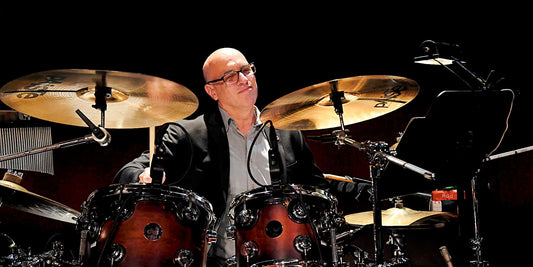
To Choose or Not To Choose!
By Dave Roth
Well, that is most definitely the question for a Broadway percussionist. There are so many factors to consider when choosing that particular instrument or that perfect mallet for that certain show or musical part. And, as the Rolling Stones always knew, “you can’t always get what you want”, so I thought I would talk about choices and decisions that I have made on particular shows on Broadway and beyond.
Once you get “that call” to do a show, the first objective for every percussionist is to find out what instruments will be required.
There are a number of different sources that might provide this. It could be the music contractor that hired you, the orchestrator, or even the music copyist might give some guidance. Many times, this list will morph between the time of that first call and that first rehearsal. And even in rehearsals and tech there might be changes that require additions or subtractions to your list. Ultimately being very flexible is a plus.
Coming from an orchestral background my sensibility was to choose the best instruments regardless of any size restrictions. No limitations on the space available or more importantly the choreography involved in accomplishing the parts. But a musical theater percussion score that would normally be played by 4 or 5 players in an orchestral performance is demanded of just 1 player and getting from point A to point B in your setup is critical. Also, many pits, particularly on Broadway due to the age of the theaters, are quite small and require some planning on the percussionist’s part. The conductor for How The Grinch Stole Christmas called me before the load in and asked if 9 by 9 feet was a big enough footprint for my setup. This was for a setup with well over 20 instruments so I told him that I would have to get back to him with an answer. He then asked me how tall I was. Well, I saw where this was going so I added an inch to my actual height and said I was 6’ 1” and he immediately responded, “No you’re not!” My point to this hilarious exchange is that many times you have to find a balance of being flexible but also hold your ground as once you score your space you may be stuck in it for a long time if the show has legs.
Now it comes time to arrange your instruments.
On Broadway the percussion setup is either purchased by the production company or rented. I personally try to get an early glimpse of the physical space that I will be moving into. That limited space can be the difference between having a full xylophone with a frame to a pit xylophone on a stand positioned over the vibraphone. I may also go with timbalitos instead of timbales just to save a little space. It might even be that you have to go with a tam-tam or gran casa that’s a couple inches smaller than what you really want just to make sure you can get it all to fit. You are always troubleshooting to look for space savers while still trying to maintain the integrity of good sound. It is a tricky game and sometimes you win with one choice but lose with another but ultimately your decision could come down to the importance and use of that particular instrument in the context of the score. Always remember the music dictates your setup. You may have a way that you normally arrange your instruments. For instance, you may prefer to have a mallet instrument as the starting point for your build and the timpani to your left. But you may not be able to have the timpani on your left like you’re accustomed to because you might have a passage that requires a quick change from playing something on the low drum and then directly to the high end of the mallet instrument. So, of course in that case you would want the timpani on your right. Or you really don’t want the tam-tam by the timpani to avoid sympathetic vibration, but you have no time to leap across the setup to go from a quick timpani lick. These are all sacrifices you make to accomplish the music first.
As percussionists we are all mallet hoarders.
I have a mallet for every occasion and every nuanced sound. If it were my choice, I would have 25 pairs of mallets in my percussion setup for every show. But early in my musical theater career I had a sub tell me I had too many damn mallets in my setup. I thought that was very rude at the time and now I laugh about that comment and that person is a great friend. He was right! There are times that you can go the extra mile and have that perfect mallet for just that perfect part, but in this world, we move at break neck speeds and adding too many choices of mallets can complicate and bog down the process of getting from one instrument to another. Not to mention it can make it really hard on those subbing for us which is the hardest and most thankless job in our community.
The Miller Machine is a perfect example of a device that has simplified this process of navigating mallet choices.
It used to be that I would have a pair of sticks or mallets in my hands and a triangle beater held with my pinky finger. I am so thankful that problem has been solved. The advent of the double ended mallets has helped some of these issues as well, but I am not always happy with the sound of a timpani mallet with a plastic bell mallet on the other end. I find the thickness and weight of the shaft of the mallet doesn’t translate to good sound production on the xylophone or bells. This is once again a time that you may have to make some sacrifices to accomplish a part. There are occasions where you might find yourself having to play a few timpani notes with xylophone mallets to accomplish a quick change. I have even used a chamois covered timpani mallet that I have played on the timpani and used that same head on the xylophone, and it created a nice, warm, big sound. There are just so many occasions to be creative and discover necessary short cuts and solutions while maintaining your sanity and professionalism.
At the end of the day you not only want to make the best choices for your show, but you also want to represent your talent and hard work while making great sounds. So maybe “you can’t always get what you want” but you can still sound like a pro!

Bio
Dave Roth has held the percussion chair on nine Broadway shows and subbed on nearly three dozen others. He has appeared in over 200 cities worldwide through various musical tours, and also had the pleasure of sharing the stage with Sir Paul McCartney, Ricky Martin, Natalie Cole, Gladys Knight, Aloe Blacc, Joni Mitchell, Art Garfunkle, Doc Severinson, Henry Mancini, Michael Martin Murphy, The Chieftains, Pincas Zuckerman, Susan Anton, and many more.
Dave is a proud endorser of Yamaha Percussion, Vic Firth, Latin Percussion, and Paiste Cymbals.
Video of Dave playing in the Broadway pit of King Kong.
- "Cobra Fight" https://www.youtube.com/watch?v=qTSm5-MBaNE
- "Air War & Bows" https://www.youtube.com/watch?v=y5l72oRO_V0
- "Skull Island" https://www.youtube.com/watch?v=GYQLabA4-Fk
Video of Dave playing How The Grinch Stole Christmas.
- "I'm One of a Kind" https://www.youtube.com/watch?v=QFr-Q4VkOmY
- "Whatchamawhoo" https://www.youtube.com/watch?v=m6qxuP3_pPA
Video of Dave performing "Buenos Aires" from the Broadway production of Evita.
https://www.youtube.com/watch?v=nWdmZScywKI
Video of Dave's Broadway percussion clinic titled "A Glimpse into the World of a Broadway Musician".
https://www.youtube.com/watch?v=1NCd6RjlQ3g
He is also a passionate advocate for those suffering from Alzheimer’s disease through CaringKind NYC.
And, just crazy enough to like finance and tax issues enough to form his own practice, Roth Tax & Financial Services.
His most treasured role is as the husband of a hero as his wife is a NYC nurse!



